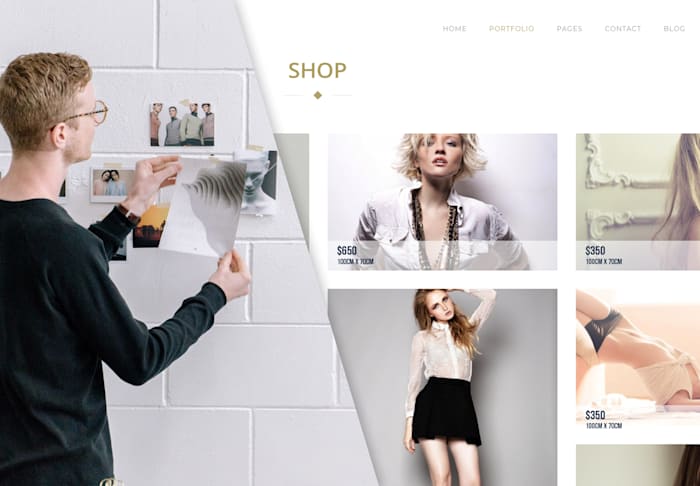What Is Etsy? How It Works (+ Selling Tips)
Is Etsy a legit place to sell goods online? What are the downsides? This guide takes you through everything about selling on Etsy.
 April 13, 2024
April 13, 2024 18 minute reading
18 minute reading
Etsy is a third-party e-commerce platform that makes it easier for small creators and businesses to expand their reach, showing (and hopefully selling to) a wide audience that may not have ever found them otherwise.
For many, this allows them to turn a side hustle into a lucrative business, building momentum and collecting reviews on a trusted site that customers are willing to purchase from.
In this post, you’ll learn everything that shop owners need to know about how to sell on Etsy so you can see how to open up your Etsy store and position it for success.
What is Etsy?
Founded in 2005, Etsy is an online e-commerce marketplace for independent makers, DIY crafters, and collectors who can open virtual storefronts to sell their products. Around 80% of sellers are women, and all are independent creators.
It's a little like Amazon for independent sellers who are selling handmade, unique, or niche products. The goal is to create an expansive marketplace of products from different sellers so that customers can find great vendors. There are over 7.47 million sellers on Etsy as of 2022 and over 95 million active buyers.
How Etsy works
Etsy is a straightforward platform for both customers and sellers.
To get started on Etsy, you just need to create an account, choose a username, and then head to the "Sell" section of their site to open up your shop (which we'll talk more about).
Sellers will set up their store with a description and profile picture, upload their inventory, and create product listings. You can customize shipping costs, carriers, and delivery times as you choose. You can also manage your shop via Etsy's website or app, tracking sales, communicating with buyers, and updating listings.
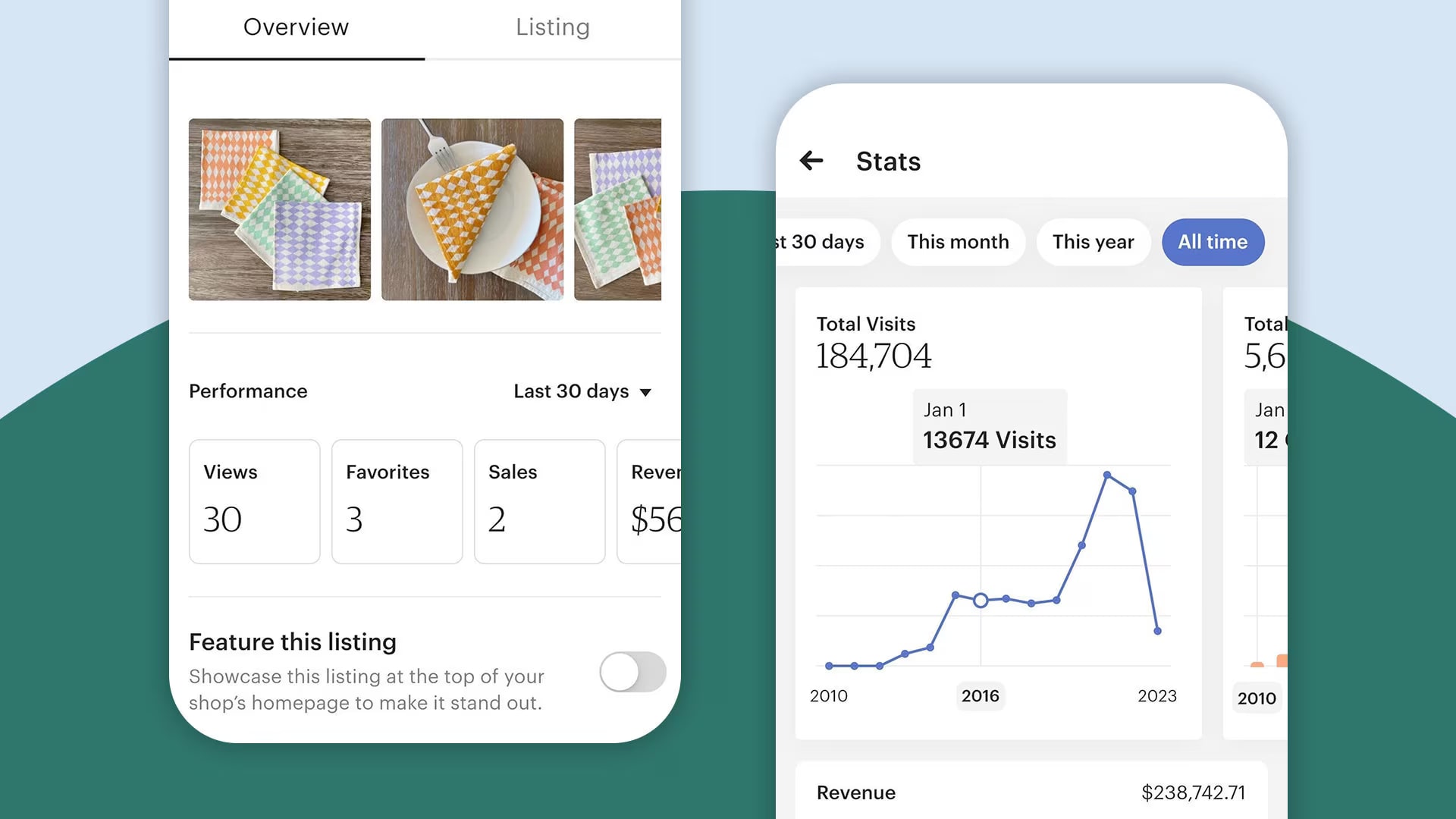
Etsy mobile app
For buyers, they can browse or search for items by category, keyword, or directly by shop name. Etsy's marketplace offers a wide range of products, from handmade jewelry and clothing to vintage items and craft supplies.
When a buyer decides to purchase an item, they can add it to their cart and proceed to checkout. Etsy offers various payment methods, including debit and credit cards, Apple Pay, PayPal, and Etsy Gift Cards.
What is the downside of Etsy?
Selling on Etsy has many benefits, like access to a global customer base already interested in handcrafted items. But, there are a few downsides to selling on the platform, such as:
Fees: Etsy charges several types of fees, including listing fees, transaction fees, and payment processing fees. These fees can add up, especially if you have slim profit margins.
Competition: With millions of sellers on Etsy, the marketplace is very competitive. Standing out among the growing number of listings is challenging, requiring good SEO (Search Engine Optimization), high-quality product photos, and unique product offerings.
Dependence on Etsy’s algorithm. Etsy uses a complex algorithm to determine how products are displayed in search results, just like Amazon. Changes to this algorithm can significantly impact your listing’s visibility and sales, and it’s often without warning.
Limited customization. Etsy doesn’t let you customize your store like having your own website. You’re confined to the layout and design constraints set by Etsy, which can limit how to show products and tell your brand story.

Every Etsy Shop has the same templated look
Is using Etsy free?
While it is free to open a storefront on Etsy, selling on Etsy does come with a price tag attached.
Their new pricing structure and policies (which launched June 23, 2021) include the following:
Listing fees. Every listing you create costs $0.20 regardless of whether or not the item sells. (The exception to this is a private listing, where you're only charged the $0.20 once it sells) Listings last four months after which they'll automatically renew for another $0.20 each unless you disable automatic renewal.
Transaction fees. Each sale processed through Etsy will incur a 6.5% transaction fee. This is 6.5% of the price displayed for the listing plus the amount charged for shipping and/or gift wrapping. As a result, it's important to factor this into your pricing structure and shipping costs.
Payment processing fees. For sellers using Etsy Payments (the primary method for processing payments on Etsy), the fees are 3% of the transaction price plus a fixed fee of $0.25 per transaction for US transactions. However, this rate can vary depending on your bank's location.
In-person selling fees. Heading to a farmer's market or a craft fair? You can use a Square reader to sell items from your Etsy store to customers in person and receive a $0.20 transaction fee along with Square's payment processing fees.
Pattern fees. Want to create your own personalized online store off of Etsy? Etsy's Pattern tool allows you to do this. Following the 30-day free trial, it has a monthly subscription fee of $15.
Regulatory operating fees. Sellers in some countries will receive Regulatory Operating fees on every transaction, which is a fee based on a fixed percentage of the price displayed in each listing plus shipping. These often come as a result of increased costs associated with compliance regulations in each country.
Shipping fees. While you can set costs so that your customers are paying for the overall shipping costs, Etsy allows sellers to purchase shipping labels for easy order fulfillment. The cost of the shipping label and add-on features like a signature confirmation or insurance will be deducted from your balance.
Currency conversion fees: If you sell in a currency different from your bank account, Etsy charges a 2.5% currency conversion fee.
Advertising fees: The Etsy Ads program allows sellers to increase visibility within Etsy, with a customizable budget. Offsite ads are automatically enabled for all users, and charge 12-15% of the sale price for items sold outside of Etsy.
👉 Read more about Etsy’s fees here.
What buying on Etsy is like
To become a customer on Etsy, you can create an account or checkout as a guest. You can then browse products by category or search for products if you have something specific in mind.
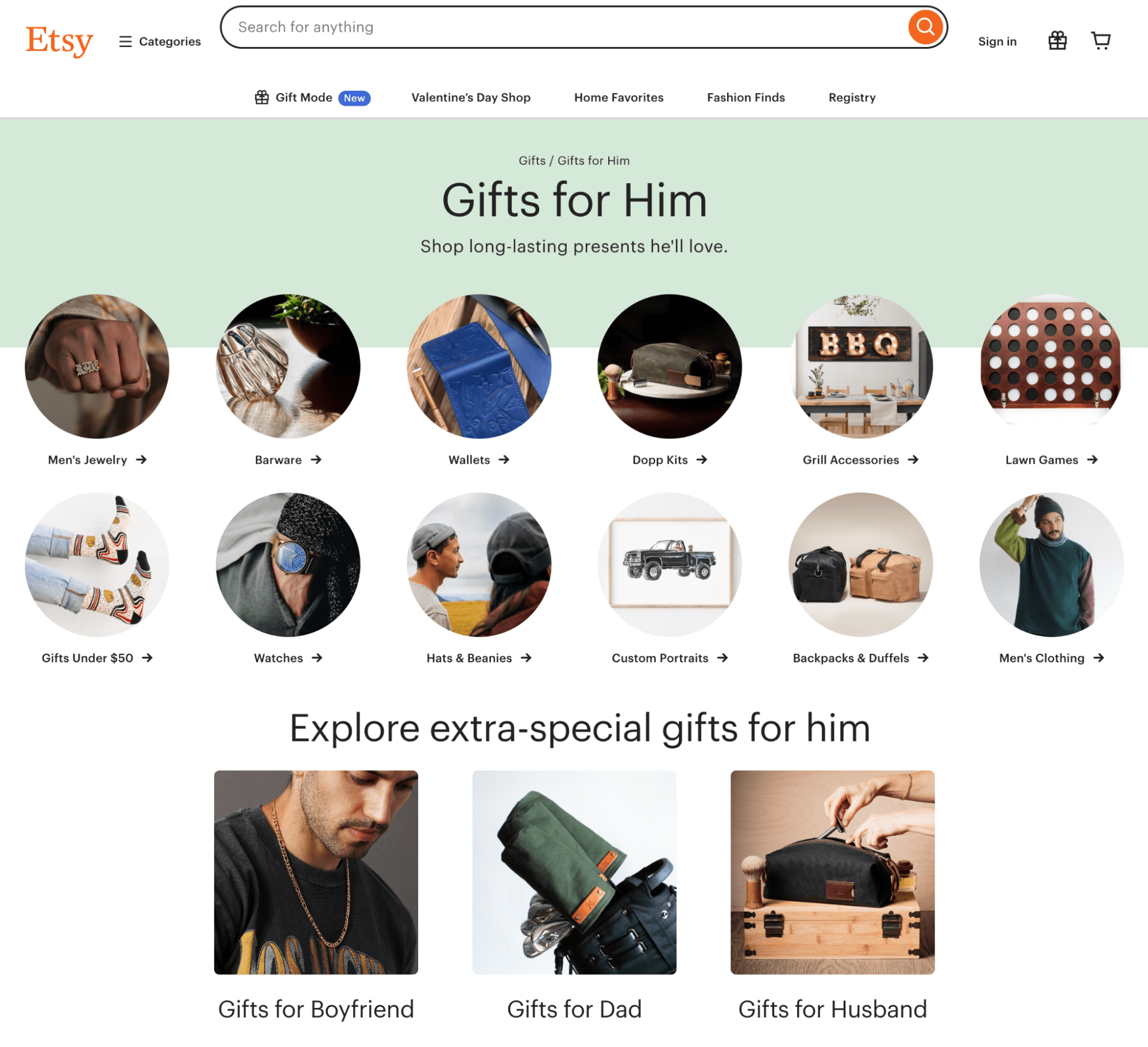
Etsy curates collections for shoppers to make finding products easier.
When you find what you're looking for, you can review detailed product descriptions, reviews on the product and the seller from other customers, and information about shipping options. Payment options vary based on the seller, but credit card, PayPal, and Klarna payment options are almost always available.
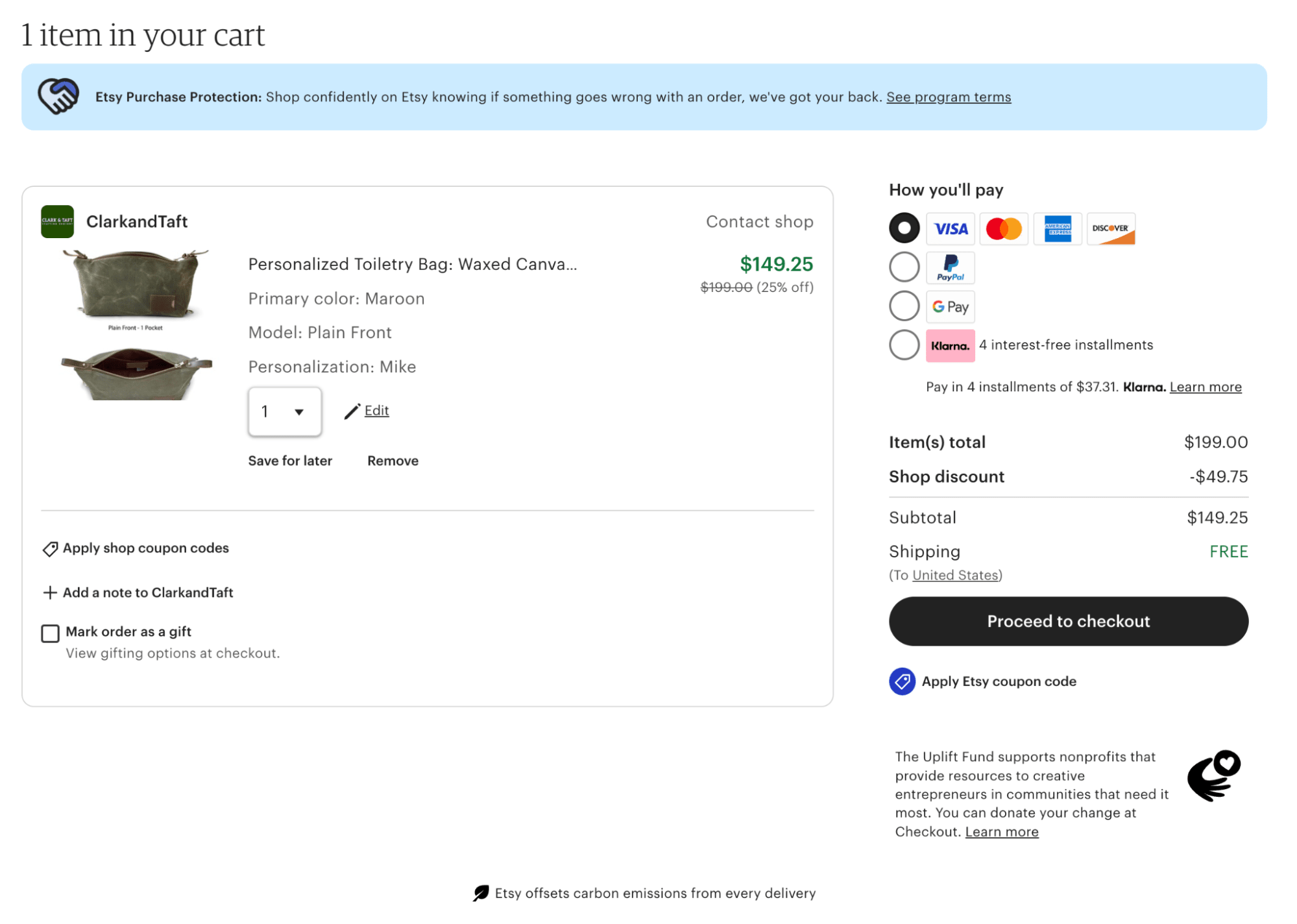
The shopping cart on Etsy.
Customers and sellers can communicate back and forth. This allows customers to ask about products before purchasing, request updates about order tracking, and discuss concerns or further questions once the item is received. Sellers can also reach out to ask for reviews.
What selling on Etsy is like
On Etsy, crafters can sell physical goods like home goods and clothing, digital downloads, vintage items (which must be 20+ years old), and craft supplies through either organic search or promoted listings.
They can do so on their terms, choosing when they'll ship out items, what shipping carriers they want to use, and how much they want to charge. They can also enable or disable different third-party payment options, giving sellers a large amount of control over their storefronts while still granting buyers high levels of flexibility that benefit them.
Meanwhile, users can browse different product categories or search exactly what they're looking for. Once they find an item they like, they can read detailed descriptions and view images of the product, check out reviews, and look at the seller's profile.
How to start an Etsy store
If you're ready to open your first Etsy shop, let's go step by step through the process of creating an account, opening and optimizing your shop, uploading product listings, and starting to make sales.
Step 1. Sign in or create an Etsy account
Creating an account on Etsy takes just a few minutes, and you'll need to create both a personal account and then, through that, set up a storefront.
Visit Etsy.com/sell and select Get started.
Answer a few questions about your business experience and if you'd like to receive additional selling resources.
Select your shop language, country, and currency, then select Save and continue.
Choose your shop name, then select Save and continue.
Step 2. Create a listing
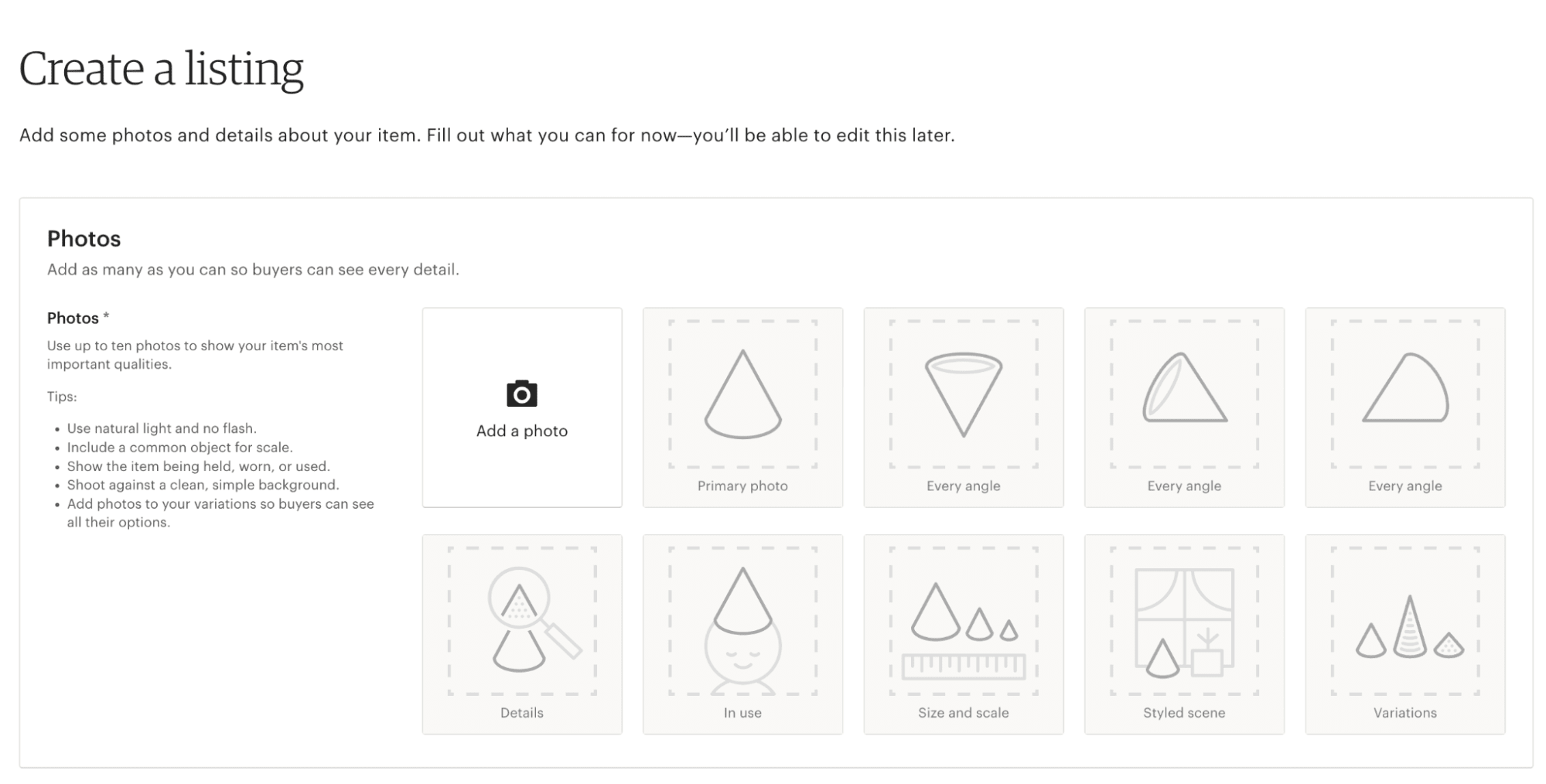
Creating a listing in Etsy
Make sure that every single product photograph that you upload is excellent. High-quality, not-cluttered images are an absolute must.
Try to include as many images of a product as possible to help a client feel comfortable about purchasing.
A clothing company, for example, could show the item from the front, from the back, and on a model. A creator selling homemade chocolate truffles could show photographs of the array of truffles, the truffles in the packaging, and a truffle broken open to show the ooey, gooey center.
For your first listing:
Add photos and video.
Choose your thumbnail image.
Add listing details (about, listing categories, attributes, etc.)
Describe your listing
Add your inventory and pricing
Step 3. Choose how you’ll get paid
With Etsy Payments, you can choose from many different payment options. In this new section, you’ll need to provide info about your bank's location, tax status, and personal details.
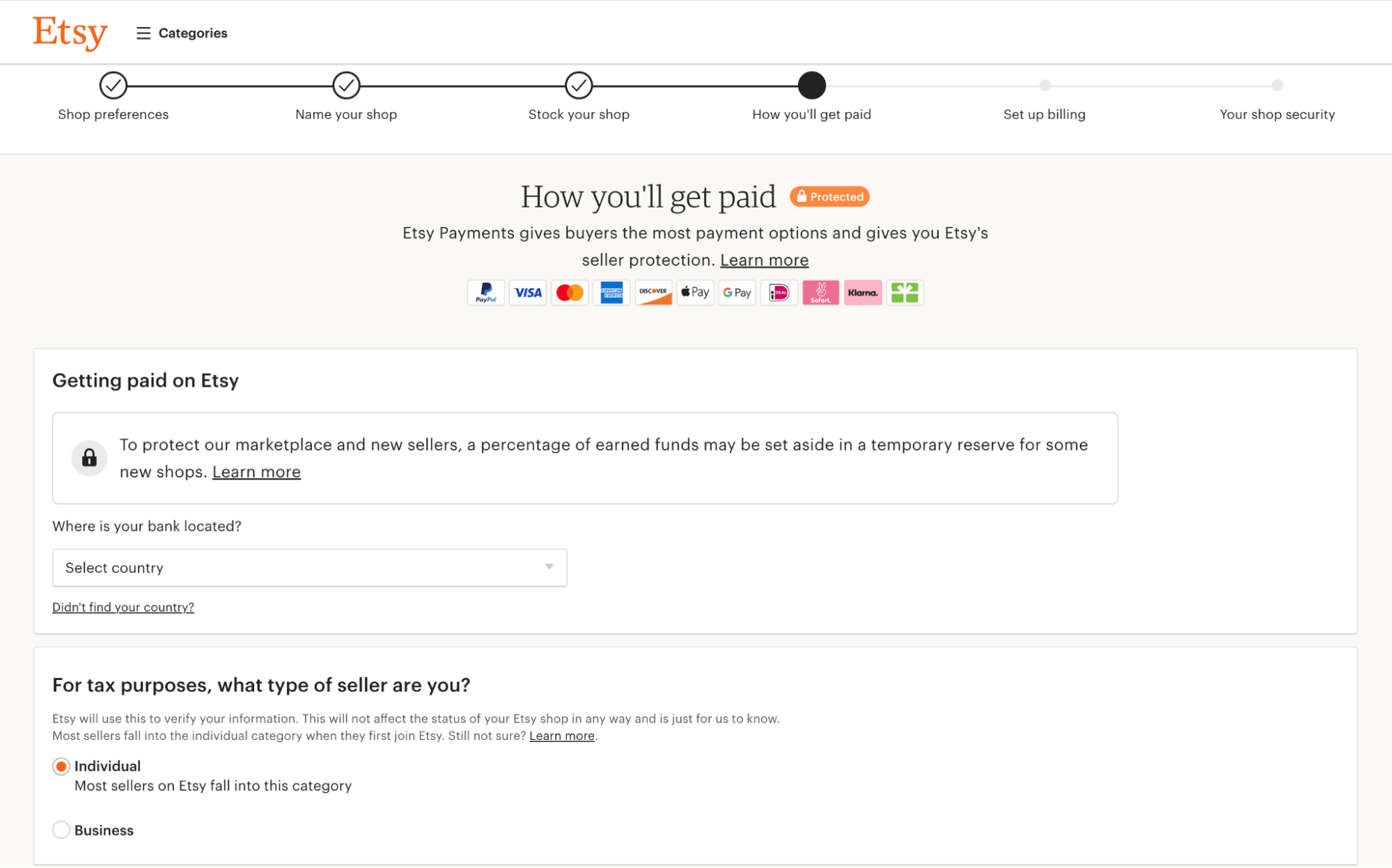
The Etsy Payments pay during set up
For sellers with a US bank account, you can connect your bank with Plaid and follow the steps to verify your details. Click Save and continue, then follow the directions to set up billing on the next page.
Step 4. Set up your security
Etsy requires you to set up two-factor authentication. When you sign in from an unrecognized browser or device, it’ll send you a verification code to access the account. You can receive the verification through:
An authenticator app on your phone
SMS
A phone call
Once you’re done, click Open your shop, and now you’re ready to customize and make it yours.
Step 5. Optimize your profile
Once your new shop is open, it's important to start optimizing it for search, visibility, and a solid first impression right away.
Make sure to use the following best practices when setting up your shop's profile:
Use a cover photo for the homepage of your storefront, which will be 3360 x 840 pixels. They are both desktop and mobile friends and should represent your brand well.
Use a shop icon that's consistent with your business logo and overall branding.
Look for keywords that users might search for to find your products. If you're selling jam, you may have relevant products for searches like "homemade jam," "organic jam," "natural preserves," and "sugar-free jam." Consider which keywords may give you the most visibility and try to include them in the profile copy and title.
Introduce any and all team members in the Shop Members section.
Write a strong "About" section for your store, explaining what you offer, what makes you unique and credible, and anything else you feel could help set you apart.
Your "About" page gives you 5,000 characters to explain who you are and what makes your small business exceptional; you want to take full advantage of that.
This is your chance to highlight why your creations are exceptional and why they should buy. You can highlight your achievements, experience, knowledge, and your business's USP.
When writing your "About" page, it helps to keep the following in mind:
Be welcoming and approachable; you want potential buyers to like you and feel a rapport with you
Talk about what made you want to start your business; storytelling is always a plus
Introduce partners or vendors that you work with to develop or source product materials
Use short, concise paragraphs and simple sentence structures
Include links to social media and/or a list to opt-in to your email list
Include links to any third-party media that mention you or your products
Step 6. Keep your shop policy simple
Etsy allows store owners to set up their own shop policies. This is a huge advantage, but it's important to remember to keep it simple; otherwise, you may end up driving users away, and those are users who were likely high intent and interested in purchasing.
Common examples of shop policies include:
Free returns within 30 days
Returns or replacements made for damaged items as long as you send proof of item receipt and damage within 5 days of the shipment being received
No returns on personalized items
Policies should be simple and straightforward. If you're unsure of where to start, Etsy has a basic shop policy template that allows you to adjust different options as you see fit.
Step 7. Add relevant categories and attributes
Users can browse different categories of products on Etsy, making it essential to ensure that your products are listed in the most accurate category possible. This helps interested customers find you.
You'll see that there are plenty of different subcategories available for every category on Etsy. Take the time to go through each one to see what best fits your brand and products.
You'll want to do the same thing for attributes, which helps the red halter dress you're selling show up when users are browsing "clothing" and then "dresses" and choose to view only red items. Attributes can include use, color, occasion, and more.
You can test different categories on Etsy to see what works for you. An easy way to do this is to check the search results for different possible categories that you think your products may fit into, and then assess which searches had results most similar to yours.
Step 8. Maximize your tags
Tags are short phrases or even single words that are 20 characters less than you would use to describe your product. And they're a big deal on Etsy, as the platform uses them to determine whether or not your product is relevant to buyer searches.
Tags, when combined with attributes and categories, wildly influence search results. It's crucial to take the time to get them right.
Tagging best practices are relatively simple:
Include tags with phrases and long-tail keywords like "organic fine ground flour" instead of just "flour"
Use all 13 tags available on every product listing
Try to use some tags that are similar to your product keywords
Check for misspellings
Only use tags in one language
Keep it relevant; only use tags that people searching for your products may want to find
Tips for selling on Etsy
When you want to start selling on Etsy, there are steps you can take to set your storefront and your ecommerce product ideas apart from the rest.
Choose a creative shop name
Your shop name does more than represent your brand; it is your brand. It can help explain to users who you are, set the tone for your shop, and help you stand out from others. It's important that it's memorable and relevant.
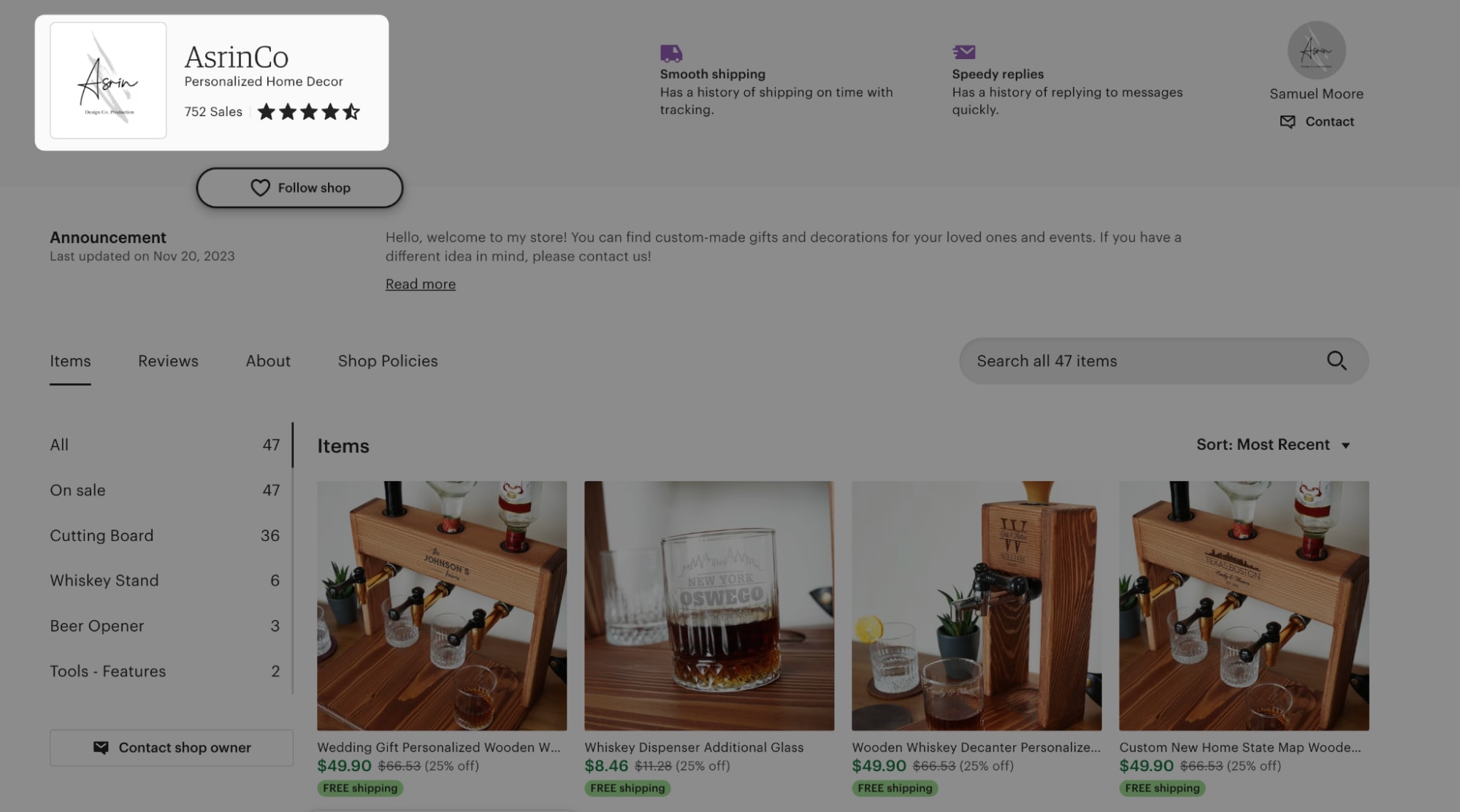
Example of a good Etsy shop name
You've got 20 characters for your shop name. You'll choose this when setting up your store. And though it can be changed at a later date, it's important to remember that brand name recognition is important; you want customers who go looking for you to be able to find you.
Ask yourself the following questions:
What is the core offering of your business?
What feeling or vibe do you want your store name to convey?
If you ask family or friends about the store name, what did they think?
Does the name look good on a business card?
Is the name easy to spell, read, and type without errors?
Is there an alternative meaning in other languages that could be offensive?
Is the name already taken?
When coming up with store names, we know that it can be difficult and that a lot hangs in the balance. Here are some creative ways to come up with high-performing names for your Etsy store:
Use descriptive names that evoke the feeling you're going for. "BoozyJams," for example, is pretty straightforward; you're going for the fun vibe of "boozy" instead of "liquor," and it's descriptive.
Consider opting for puns or creative word choices. Puns can be memorable and show a sense of humor that customers love. "NoWayCrochet," for example, tells users that you're offering crochet goods and that you've got a sense of humor.
Try combining two words. Trying to find something creative for your home-grown plant business? Try something like "Plantastic" or "Plantorama." It's on-topic but something that others are unlikely to have.
Write effective product descriptions
Product descriptions matter. They explain why users should purchase, and it should detail the product's condition, age, physical description, uses, measurements, ingredients, and (if relevant) manufacturing process.
The product descriptions often carry equal weight to the product photographs as being the two big factors that most influence purchase. The product description is an integral part of your listing. It details your product’s measurements, condition, color description, and instructions.
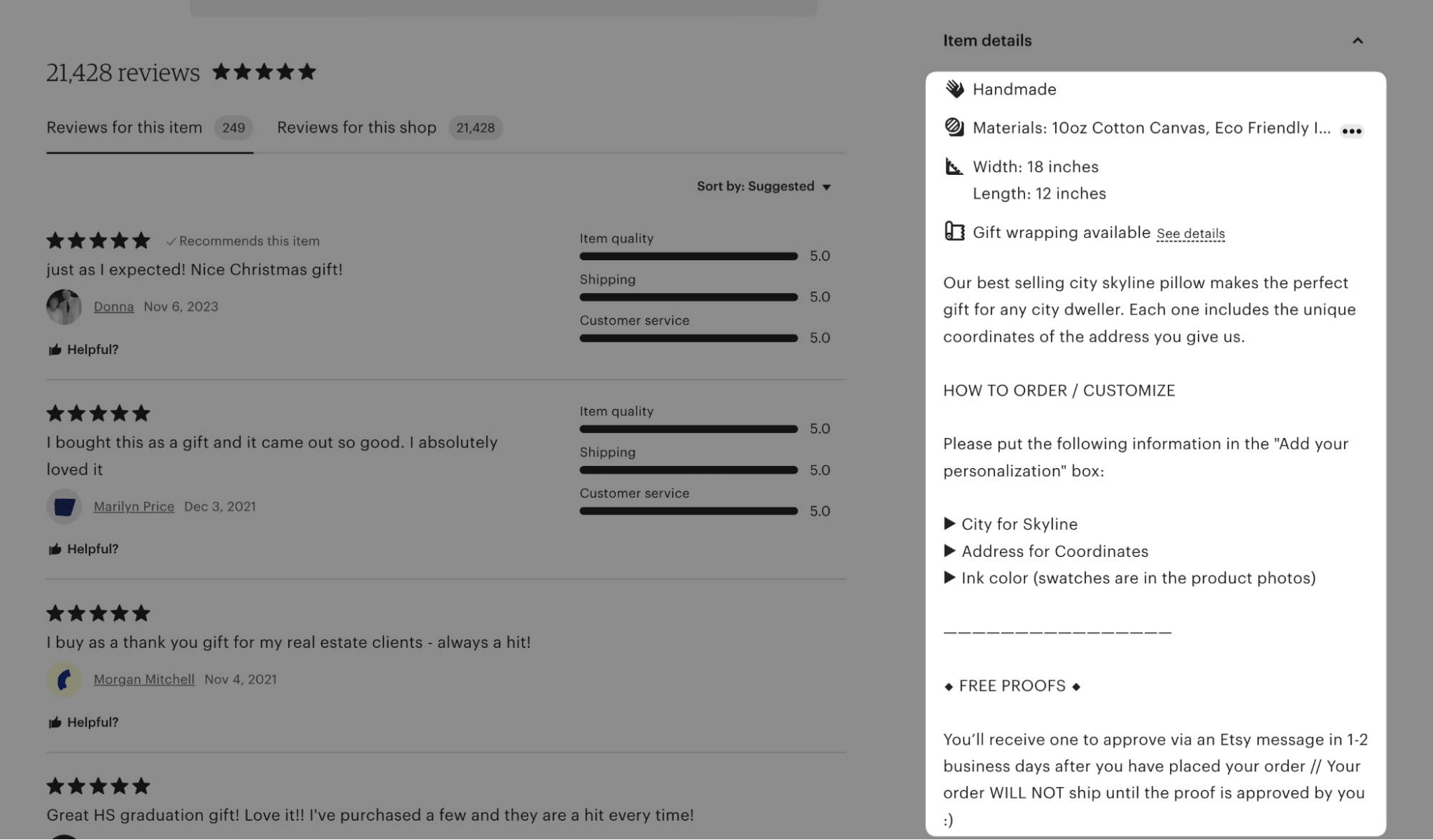
Product description example for Personalized Skyline Pillow Gift.
Some product description best practices include:
Specify who the product can help and what pain points it can resolve
Mention the materials or techniques that went into product development, including relevant information like "small-batch" or "gluten-free made"
Use keywords that you included in your tags or attributes if possible
Always mention the age of vintage products in the descriptions
Think about using descriptive terms like "modern," "boho," "natural," or "calming," as these can come up in search
Detail the dimensions and weight of the product and if possible the size of the package when shipped
Include information on how long it will take to create and ship the product from the order date
Use simple sentences and short paragraphs, but rich language, and don't be afraid to keep it interesting with the copy
Post high-quality photographs
You need to post original photographs, but they still need to be dazzling. As users are browsing, they're going to choose the ones that look the most more often than not. Use high-resolution, clean images that clearly show the product. Include multiple images on the product page for best results.
Optimize for search
Many people are using Etsy as a search platform to find products they want, whether it's a fifty-year-old sourdough starter or a wreath for Christmas. Etsy SEO is a great marketing idea to get your products seen by more people.
Whatever you're selling, make sure that each listing is optimized to show up in search when users are looking. Include keywords in the product description, and consider using different keywords in the product listing to cover your bases.
Treat your storefront like an actual storefront
If you want to turn Etsy into a viable income, treat it like the online business opportunity that it can be. Choose a great profile picture (which can be a custom logo), use consistent branded images, and make sure that the personal profile attached to your business profile is strong, welcoming, and approachable.
Many Etsy sellers also open an online shop with Shopify also. This gives you more control over your ecommerce business as it relates to branding and customer experience. It’s also a good way to diversify your income streams as a full-time Etsy business owner.
Provide great customer service
Potential customers may reach out to ask questions before making a purchase. Existing customers may reach out to follow up on an order or to request help if something went wrong. Getting great customer service will make them want to purchase again and leave great reviews. Both help your business.
Research the top competitors in your space
You can learn so much from even a short bout of competitor analysis. You can see how users are writing about their products, what terms they're showing up in a search for, how they're pricing products, and what reviews say about them. Use this information to improve your own business.
Build a social media following
Some popular Etsy creators build dedicated followings just like businesses do, and these users will happily follow you on social media. Create an Instagram, a Facebook Page, or even a Facebook Group to keep your enthusiastic customers up to date about everything happening with your business.
Consider custom, branded packaging
This goes back to "treat it like a real business because it is." You can purchase custom, branded packaging supplies like boxes, mailing envelopes, product labels, and even thank you cards or usage brochures that come in handy every time you fulfill an order.
Offer discounts for future purchases
Want to incentivize repeat purchases? Etsy has features in place that allow sellers to generate custom coupon codes. You can send these out at any point, but you can also send them in postcards or messages after a customer converts, encouraging them to purchase again later.
Become part of the Etsy community
Want to help your storefront and account to gain some credibility quickly? Integrate yourself into the Etsy community. Participate in the forums without being overly promotional, and try to partner up with other Etsy sellers to create enticing package deals. Trust can go a long way.
Create your Etsy store today
While there are both pros and cons to selling on Etsy, the reality is that it's a little like a creator's ecommerce paradise in many ways.
There's a massive, engaged, and trusting audience on Etsy. Here, users are more willing to buy from small entrepreneurs than they might be on a site like Amazon because the goal is to try to find handmade items from niche creators. The fees are also relatively low cost compared to some other platforms, and the ease of setup and continual use is hard to pass by.
If you're ready to sell products online, Etsy is just a few clicks away. It might be time to get started. Need help with your Etsy store? Check out Fiverr’s Etsy Shop services to grow your business.
Etsy FAQ
What is Etsy and is it legit?
Etsy is an online marketplace that specializes in handmade products, vintage, unique goods, and even digital products like ebooks. Founded in 2005, it is a legitimate company and has grown to become one of the most popular platforms for artists, craftsmen, and collectors.
What is Etsy mainly used for?
Etsy is used primarily for buying and selling handmade goods, home decor, vintage goods (at least 20 years old), and craft supplies. It caters to consumers searching for personalized, unique products that are not typically found in traditional retail stores.
Who is Etsy's biggest competitor?
Etsy's biggest competitor varies depending on the market segment, but Amazon Handmade is often cited as a major competitor due to Amazon's vast resources and reach. In addition to eBay and other niche sites that specialize in handmade or vintage goods, Amazon Handmade is a direct competitor to Etsy's handmade and artisan market.
